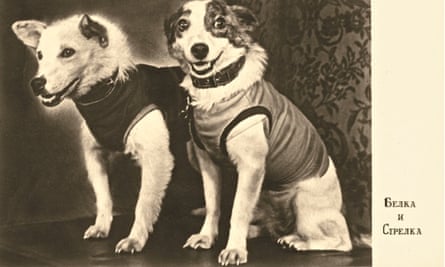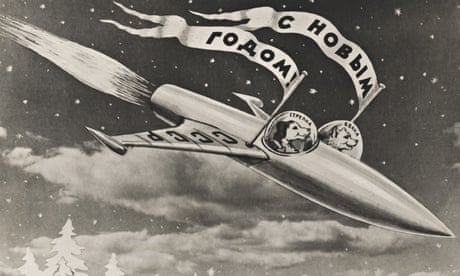A streamlined space rocket streaks across the starry sky on a packet of Soviet cigarettes, trailing triumphant slogans, while another spaceship soars past planets on a commemorative plate. The pointed nosecones of satellites sparkle on lapel badges and postage stamps, while further galactic adventures are enacted across the lids of biscuit tins. Produced in the USSR in the 1950s, this collection of memorabilia looks like any other haul of space-race propaganda – until you notice that something's not quite right. Instead of the usual heroic comrades peering from the spaceships' windows, chiselled jaws framed inside the bubble masks of their spacesuits, there are the furry faces of beaming dogs. It could be merchandise from a parallel universe in which our world is ruled by canine overlords.
"We were really struck by the utter surrealism of these images when we first saw them," says Damon Murray of Fuel, publisher of a new book that tells the unlikely story of the Soviet space dogs. "It's more fantastical than the wildest science-fiction comics. You couldn't come up with this stuff if you tried."
Emblazoned on sweet wrappers and matchboxes, postcards and handkerchiefs, the space dogs became cult figures in the Soviet Union of the 1950s and 60s, embodying the plucky spirit of the country's pursuit of space exploration. They appeared on TV and radio, their portraits printed in newspapers and magazines, while politicians queued to be photographed with them, as the first "space pop stars". But behind the scenes, their lives weren't quite so glamorous.
Scavenged from Moscow's backstreets, the stray mongrels were to be the guinea pigs of manned spaceflight, some of the first living creatures to be sent into orbit. Continuing a long tradition of experimenting with dogs, following Ivan Pavlov's work on conditioned reflexes in the 19th century, strays were selected for being naturally hardy. It was thought that their lives fending for themselves would have prepared them to tolerate the traumas of space flight better than domesticated hounds, and help them to stand up to the extreme stresses of weightlessness, cosmic radiation and high G-forces. Monkeys, although used in the American space programme, had been rejected by the Russians for being too emotionally unstable and fidgety. Placid, long-suffering dogs were to become an astronaut's best friend.

The "future space scouts", as they were known, had to be no heavier than 6kg (13lb), and no taller than 35cm (14in), just small enough to fit inside a rocket's nosecone, where they would be confined for days on end. They also had to be female, owing to bitches' calmer temperaments, and because there was no room in the cabin for male dogs to cock their legs (the tricky problem of excretion was handled by a special suction device built into the bespoke pressure-suits).
While it may seem obvious when you see them adorning posters and badges, it took some time for the Soviet space programme to cotton on to the PR potentials of dogs in spacesuits. At the launch of the second manufactured satellite, Sputnik 2, in 1957, the dog was merely listed as another item on board: "airtight container with an experimental animal (canine)," the press release stated, alongside, "air-conditioning system, food supply and research equipment for studying life functions in the conditions of outer space".
Derogatorily nicknamed Muttnik by the Americans, the first dog in space, Laika, became a national hero when she died in action, supposedly euthanised on her seventh day in orbit. In fact, she had suffocated a few hours after the launch, a state secret that was revealed only in 2002. She became something of a viral meme around the world, featured on the pages of Italian comics and Japanese spinning tops – and inspiring the name of a Finnish rock band and a UK indie group.
But not all onlookers were impressed. Celebrated as a martyr in the USSR, Laika was described as the "fuzziest, loneliest, unhappiest dog in the world" by a report in the Times. She stood as a symbol of the ruthless Soviet pursuit of technological progress over animal welfare.

Back home in the USSR, the scientists vowed never to let another dog die in space, and were quick to unveil the next heroes, Belka and Strelka, the cheerful dog duo who would captain the next orbital flight in 1960. After a live broadcast that showed them merrily spinning in zero gravity, they returned safely to a wave of affection, and all the sausages they could eat. Sent on tour in their neatly tailored spacesuits – one red, one green – and immortalised in porcelain figurines, their cheery valour masked the fact that the original team, Chaika and Lisichka, had died a month earlier, when their rocket exploded on the launchpad.
There would be at least six more dog flights before scientists were convinced space was safe enough for humans, but Belka and Strelka would remain beloved national celebrities, eclipsing their human peers. After their landing, Soviet schools even initiated lessons on how to be kind to stray dogs, while the price of mixed-breed puppies doubled. After all, any mongrel, if it wasn't too big, could become a cosmonaut.
Although the last dog flight took off in 1966, concluding around 50 such missions, space dog fever continues, with plans to erect a 5m-high (16ft) memorial in the town of Tomilino, near Moscow, at the site of the Zvezda plant, where the dogs' spacesuits were made. It will depict Belka and Strelka peering out together from inside a giant space helmet, atop a swooshing arrow, emblazoned with the letters USSR and crowned with stars.
The Russian space programme has now moved on to sending "gecko sexplorers" into orbit, to test the effects of zero gravity on reproduction. We can only guess what strange kinds of ephemera these might spawn.
Soviet Space Dogs is published by Fuel.

Comments (…)
Sign in or create your Guardian account to join the discussion